Table of Contents
- Introduction
- Editor’s Choice
- Global Cookies Market Overview
- Nutritional Composition of Cookies Statistics
- Fastest Rising Ingredients & Flavors for Cookies
- Cookies Sales Statistics
- Consumer Preferences in Cookies Consumption Statistics
- Cookie and Cracker Consumption – By Country Statistics
- Top Cookies Exporting Nations Statistics
- Latest Trends in Cookies & Snacking
- Regulatory Requirements for Cookies Statistics
- Recent Developments
- Conclusion
- FAQs
Introduction
Cookies Statistics: Cookies, also known as biscuits in some places, are popular baked treats made from a mixture of flour, sugar, fat, and flavourings such as chocolate chips or nuts.
They come in a variety of types like chocolate chip, oatmeal, and peanut butter, each with its unique taste and texture.
Making cookies involves combining the ingredients, shaping the dough, and baking until they turn golden brown. People often enjoy cookies on their own or with hot drinks.
Nowadays, there’s an increasing demand for healthier options like gluten-free and vegan cookies, as well as for artisanal and gourmet varieties made with high-quality ingredients. Overall, cookies remain a beloved snack enjoyed by people of all ages worldwide.
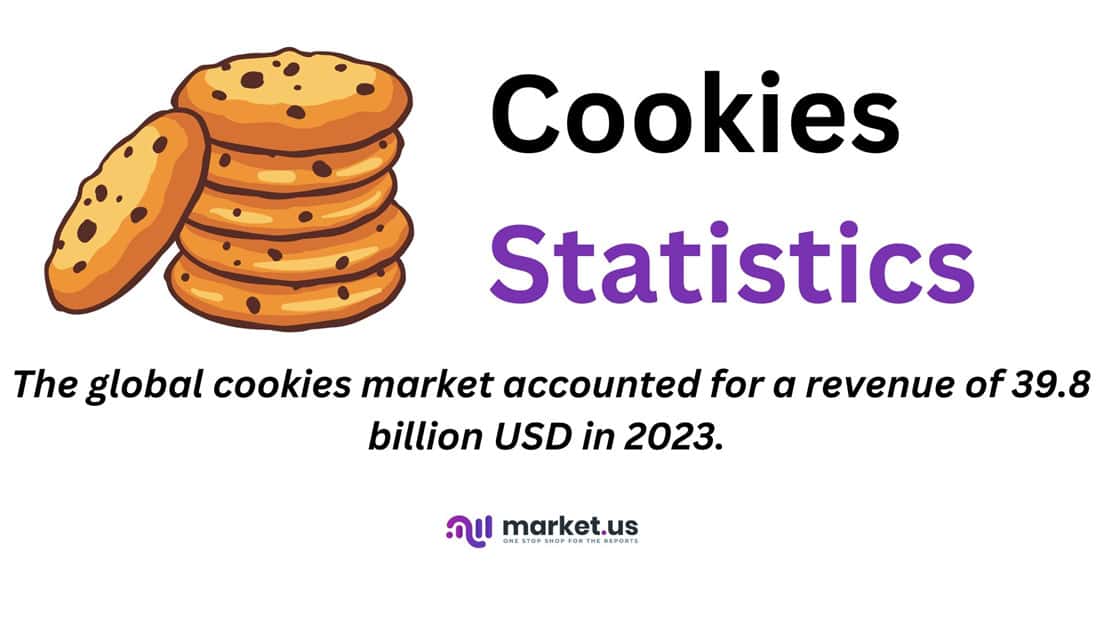
Editor’s Choice
- The global cookies market accounted for a revenue of 39.8 billion USD in 2023.
- Mondelez International leads the competitive landscape with a significant market share of 15%.
- Europe emerges as the dominant region with the largest market share, capturing 36.0% of the market.
- Cookies contain a total of 171 calories, with 80 calories derived from fat.
- Among the array of ingredients and flavors incorporated into cookies, gingerbread leads the trend with an impressive growth rate of 26.32%, reflecting a heightened preference for its warm and spicy flavor profile.
- A majority of consumers show interest in trying a new cookie if it offers a distinctive flavor, while almost a quarter of consumers report an increase in cookie consumption compared to the previous year.
- In 2014, Argentina led the list with the highest consumption, with individuals averaging 12.44 kilograms annually.
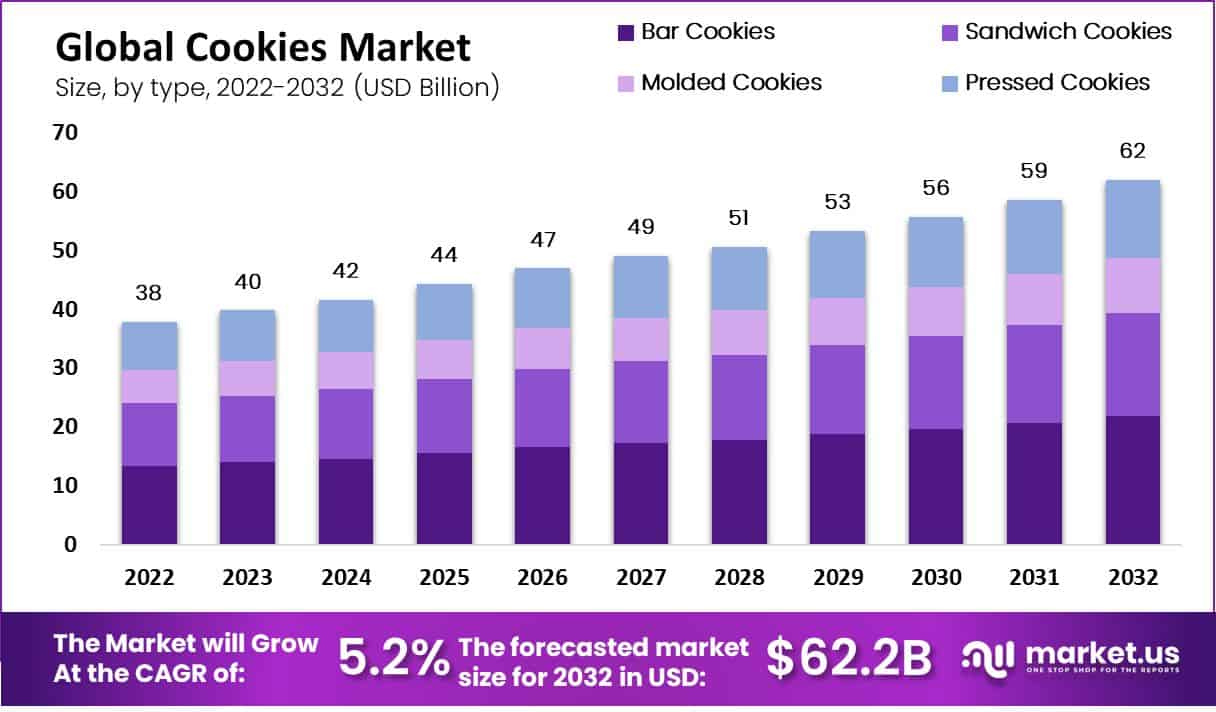
Global Cookies Market Overview
Global Cookies Market Size Statistics
- The global cookies market has demonstrated steady growth in revenue over the years, with a notable increase from 37.8 billion USD in 2022 to 62.2 billion USD in 2032 at a CAGR of 5.2%.
- This growth trend reflects the enduring popularity of cookies as a favored snack choice worldwide.
- The market experienced incremental gains annually, with revenue reaching 39.8 billion USD in 2023 and progressively rising to 41.6 billion USD in 2024, 44.4 billion USD in 2025, and 47.0 billion USD in 2026.
- The upward trajectory continued through the following years, with revenue reaching 49.2 billion USD in 2027, 50.7 billion USD in 2028, and 53.4 billion USD in 2029.
- The market’s expansion persisted, culminating in revenue of 55.8 billion USD in 2030, 58.8 billion USD in 2031, and finally, 62.2 billion USD in 2032.
- This sustained growth indicates a robust demand for cookies across various regions, underlining their status as a global beloved snack choice for consumers.
(Source: Market.us)
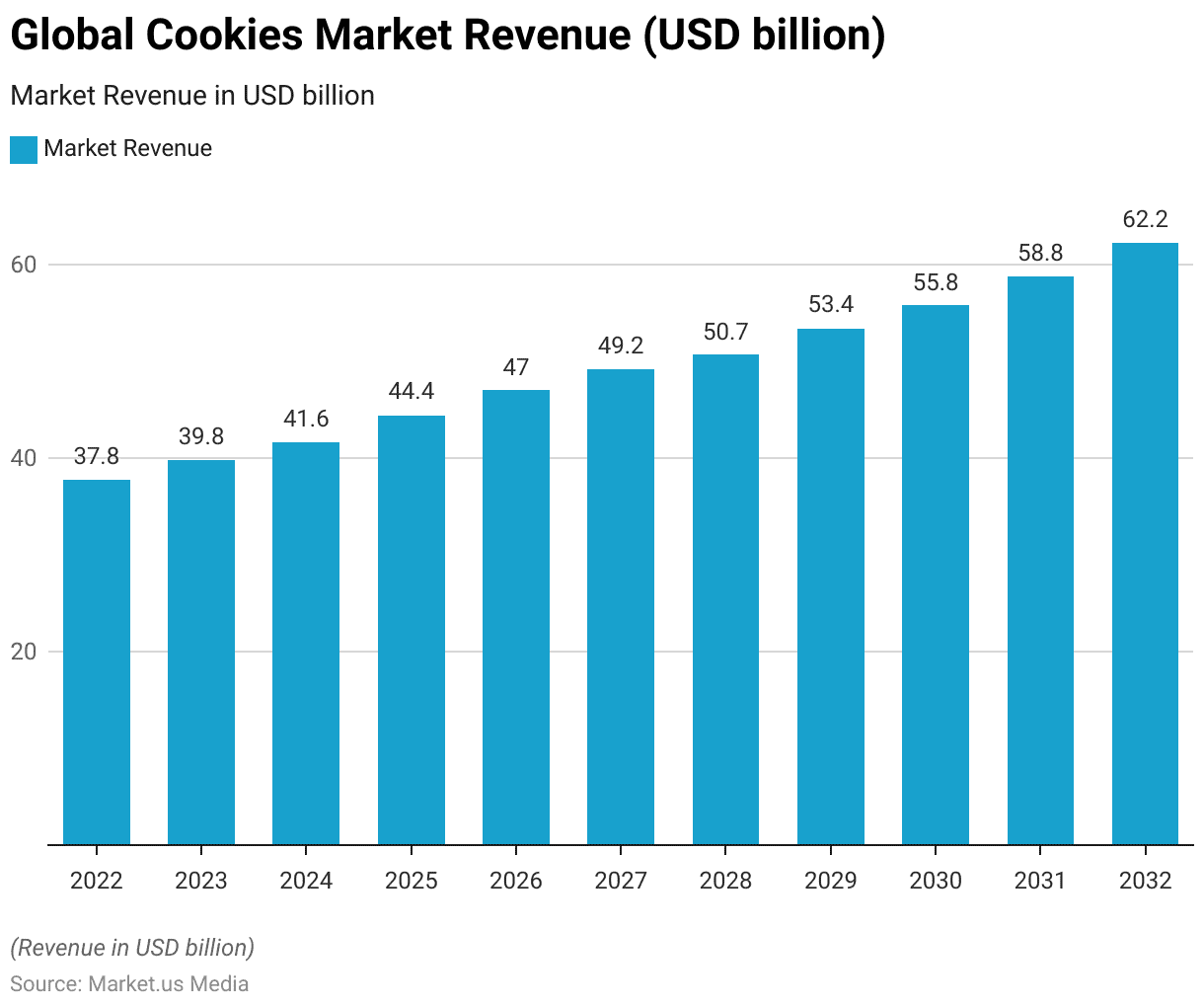
Key Players in the Global Cookies Market Statistics
- In the global cookies market, several key players dominate the landscape, each contributing to the industry’s dynamics.
- Mondelez International leads the pack with a significant market share of 15%, followed closely by Britannia Industries Ltd. and Campbell Soup Company, each holding 10% and 11% respectively.
- Ferrero International S.A. and PepsiCo Inc. also play substantial roles, both commanding an 11% share.
- Meanwhile, McKee Food Corporation and Bahlsen GmbH contribute 5% and 9% respectively. Another notable player in the market is Brittania Industries Ltd., securing an 8% share.
- Collectively, these companies represent the majority of the market, with other key players accounting for the remaining 22%.
- Their presence underscores the competitive landscape of the cookies market, where established brands vie for consumer preference and market dominance.
(Source: Market.us)
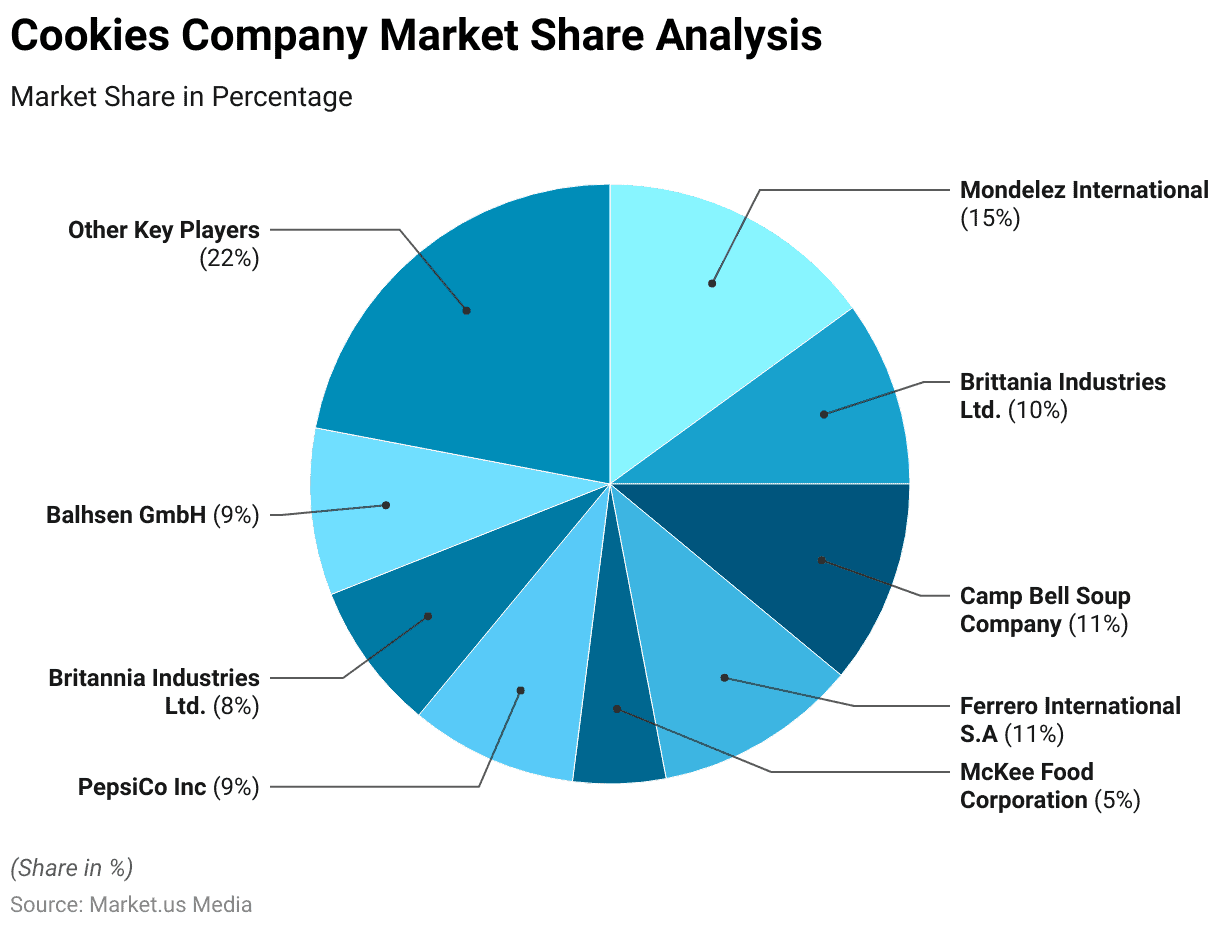
Regional Analysis of the Global Cookies Market Statistics
- The regional analysis of the global cookies market reveals varying market shares across different geographical areas.
- Europe emerges as the dominant region with the largest market share, capturing 36.0% of the market.
- Following closely behind is North America, holding a substantial share of 29.0%.
- In the Asia-Pacific (APAC) region, the market share stands at 16.2%, reflecting significant but comparatively lower consumption levels.
- Latin America and the Middle East & Africa (MEA) regions contribute 14.6% and 4.2% respectively to the global market.
- These regional disparities in market shares underscore the diverse consumption patterns and preferences across different parts of the world.
- Overall, Europe and North America emerge as the primary markets for cookies, while APAC, Latin America, and MEA regions also play significant roles in shaping the global cookies market landscape.
(Source: Market.us)
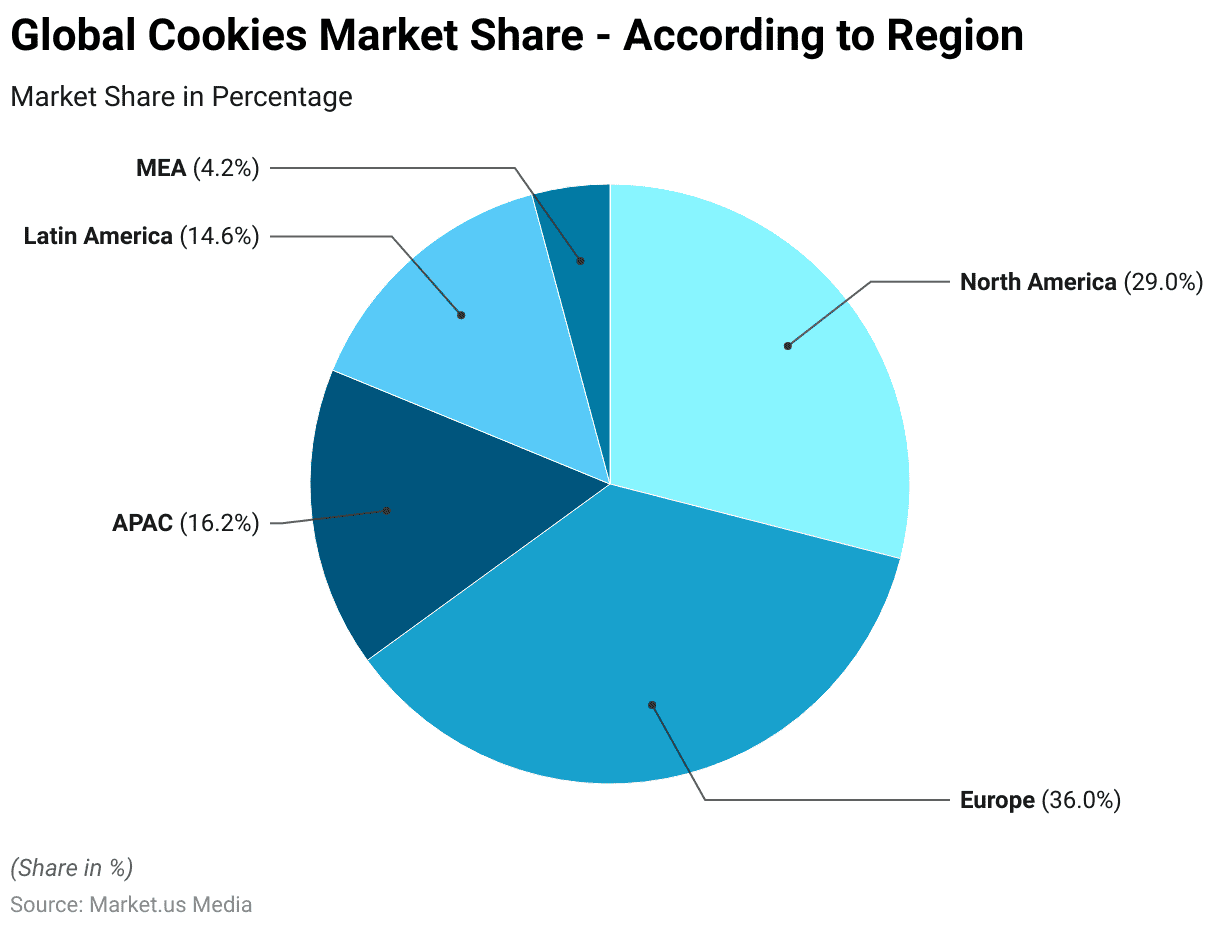
Nutritional Composition of Cookies Statistics
- The nutritional composition of two large cookies, each serving 54 grams, is diverse.
- These cookies contain a total of 171 calories, with 80 calories derived from fat.
- They contain 8.8 grams of total fat, constituting 14% of the recommended daily intake.
- Cholesterol content is minimal at 1 milligram, representing 0% of the daily value.
- The cookies provide 153 milligrams of sodium, contributing 6% to the daily intake recommendation. Additionally, each serving contains 2.5 grams of protein.
- Total carbohydrates amount to 22.0 grams, with 7% of the daily value, including 2.0 grams of dietary fiber.
- In terms of vitamins and minerals, the cookies contain 0% of the recommended daily intake for Vitamin A, 2% for calcium, and 4% for iron.
(Source: National Institute of Food Technology and Entrepreneurship and Management)
Fastest Rising Ingredients & Flavors for Cookies
- Among the array of ingredients and flavors incorporated into cookies, certain options have seen notable growth rates, indicating rising popularity among consumers.
- Gingerbread leads the trend with an impressive growth rate of 26.32%, reflecting a heightened preference for its warm and spicy flavor profile.
- Tea-infused cookies follow suit, experiencing a significant surge in demand with a growth rate of 16.85%.
- Berry-flavored cookies also witness a notable uptick in popularity, boasting an 8.96% growth rate.
- Biscuit and coffee flavors round out the list, with growth rates of 8.21% and 6.27% respectively, indicating sustained interest in these classic flavors among cookie enthusiasts.
- These trends underscore evolving consumer tastes and preferences, driving innovation and diversity within the cookies market.
(Source: Tastewise)
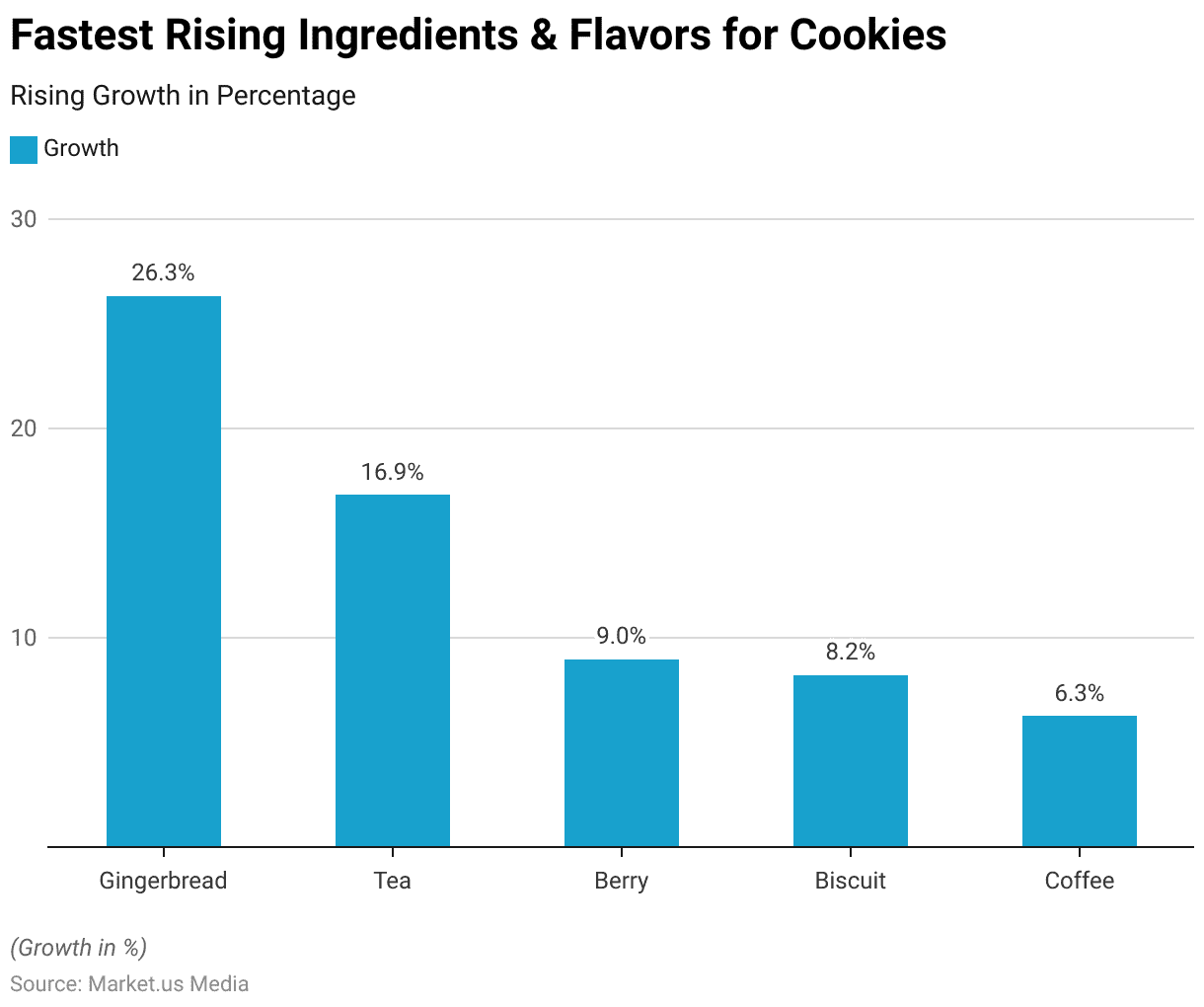
Cookies Sales Statistics
Center Store Cookies
- Over the past 52 weeks ending on March 26, 2023, data from Circana in Chicago reveals significant growth in the “center store cookies” category, which includes pre-packaged bakery items.
- Sales within this category surged by 27.5% compared to the same period in 2022, amounting to a total of $991 million in sales.
- In the “center store traditional cookies” category, sales reached $833 million, marking a 26.7% increase.
- Meanwhile, the “center store iced/frosted cookies” category generated $142 million in sales, experiencing a 30.4% increase.
- Notably, the “center store assorted/multi-pack cookies” subsection saw sales of $11.3 million, reflecting a remarkable 73.6% increase from 2022.
- Key players in the “center store traditional cookies” segment include McKee Foods Corp., reporting $757 million in sales and a 27.6% increase, Grupo Bimbo with $31.3 million in sales and a 10.9% increase, and Chattanooga Bakery Inc., with $15.9 million in sales and a 29.7% increase from the previous year.
(Source: State of the Snack Food & Wholesale Bakery Industry 2023)
Perimeter Cookies
- In 2023, the “perimeter cookies” category, which includes freshly baked options, sales reached $2.5 billion, marking an increase of 15.2% from 2022.
- Specifically, in 2023, the “perimeter traditional cookies” subsection accounted for $1.669 billion in sales, representing an increase of 15.8%.
- Additionally, the “perimeter specialty cookies” subsection brought in $203 million, showing a 14.5% increase, while the “perimeter iced/frosted cookies” subsection saw sales of $399 million, reflecting a 20.1% increase.
- Lastly, sales in the “perimeter multi-pack/assorted cookies” section totaled $179 million, with a 16.9% increase compared to the previous year.
(Source: State of the Snack Food & Wholesale Bakery Industry 2023)
Consumer Preferences in Cookies Consumption Statistics
- A majority of consumers show interest in trying a new cookie if it offers a distinctive flavor, while almost a quarter of consumers report an increase in cookie consumption compared to the previous year.
- The primary reasons for consuming cookies vary among individuals, but certain trends emerge from consumer responses.
- A significant majority, accounting for 56%, cite treating themselves or their households more as a top motivation for indulging in cookies. This reflects a desire for small indulgences and moments of self-care.
- Additionally, 50% of respondents mention baking more often as a reason for consuming cookies, suggesting increased home baking activities and a preference for freshly made treats.
- Moreover, 45% express a need for more comfort, indicating that cookies serve as a source of solace and nostalgia during challenging times.
- These reasons underscore the multifaceted role that cookies play in providing both physical pleasure and emotional comfort to consumers.
(Source: Barry Callebaut Survey)
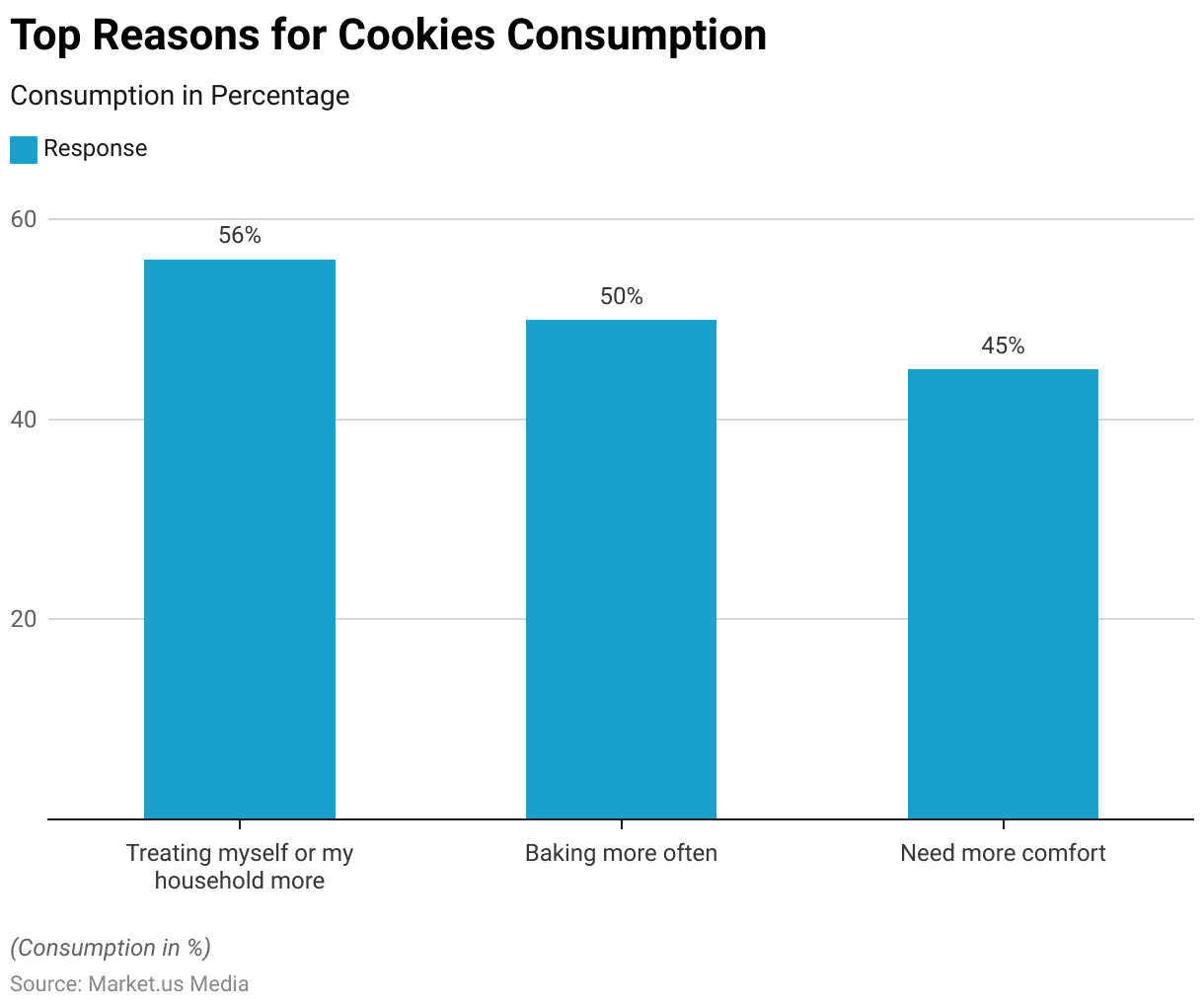
Cookie and Cracker Consumption – By Country Statistics
- In 2014, the per capita consumption of cookies and crackers varied significantly by country.
- Argentina led the list with the highest consumption, with individuals averaging 12.44 kilograms annually.
- Following closely behind was the United Kingdom, where per capita consumption stood at 10.02 kilograms.
- Italy and the United States recorded consumption rates of 7.37 kilograms and 6.91 kilograms respectively.
- Brazil, Russia, and France also demonstrated considerable consumption levels, ranging from 5.75 to 5.56 kilograms per capita.
- Meanwhile, Mexico showed a slightly lower consumption rate of 4.75 kilograms.
- In contrast, China and India had notably lower consumption rates, with individuals averaging 2.23 kilograms and 1.37 kilograms respectively.
- These figures reflect the varying preferences and cultural factors influencing cookie and cracker consumption across different regions globally.
(Source: Statista)
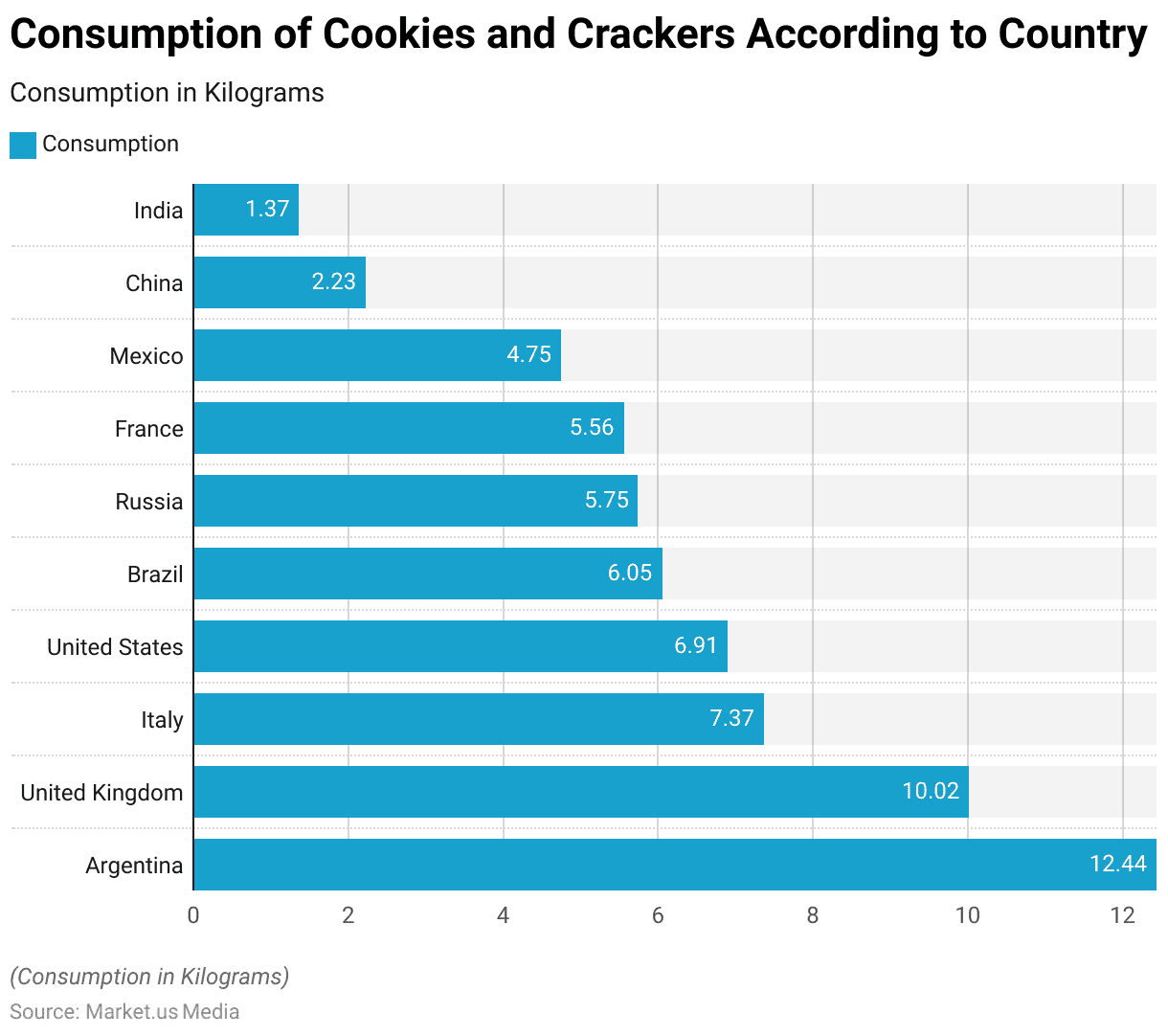
Top Cookies Exporting Nations Statistics
- The top exporters of cookies by country are led by Mexico, with exports totaling $1,168,551,000 and showing a growth rate of 24.2%.
- Following closely behind are Germany and the Netherlands, with exports valued at $840,811,000 and $840,333,000 respectively, both experiencing modest growth rates.
- Belgium and Canada also feature prominently in the list, exporting cookies worth $618,510,000 and $564,494,000 respectively, with notable growth rates.
- Turkey and Italy follow suit, with exports of $431,826,000 and $405,173,000 respectively, both exhibiting strong growth.
- The United Kingdom, Poland, and Indonesia further contribute to cookie exports, each showing positive growth trends. Spain, France, India, the Czech Republic, and the United States round out the list, with varying exports and growth rates.
- These countries collectively represent the leading exporters of cookies globally, reflecting the widespread popularity and demand for this confectionery product.
(Source: World Exports)
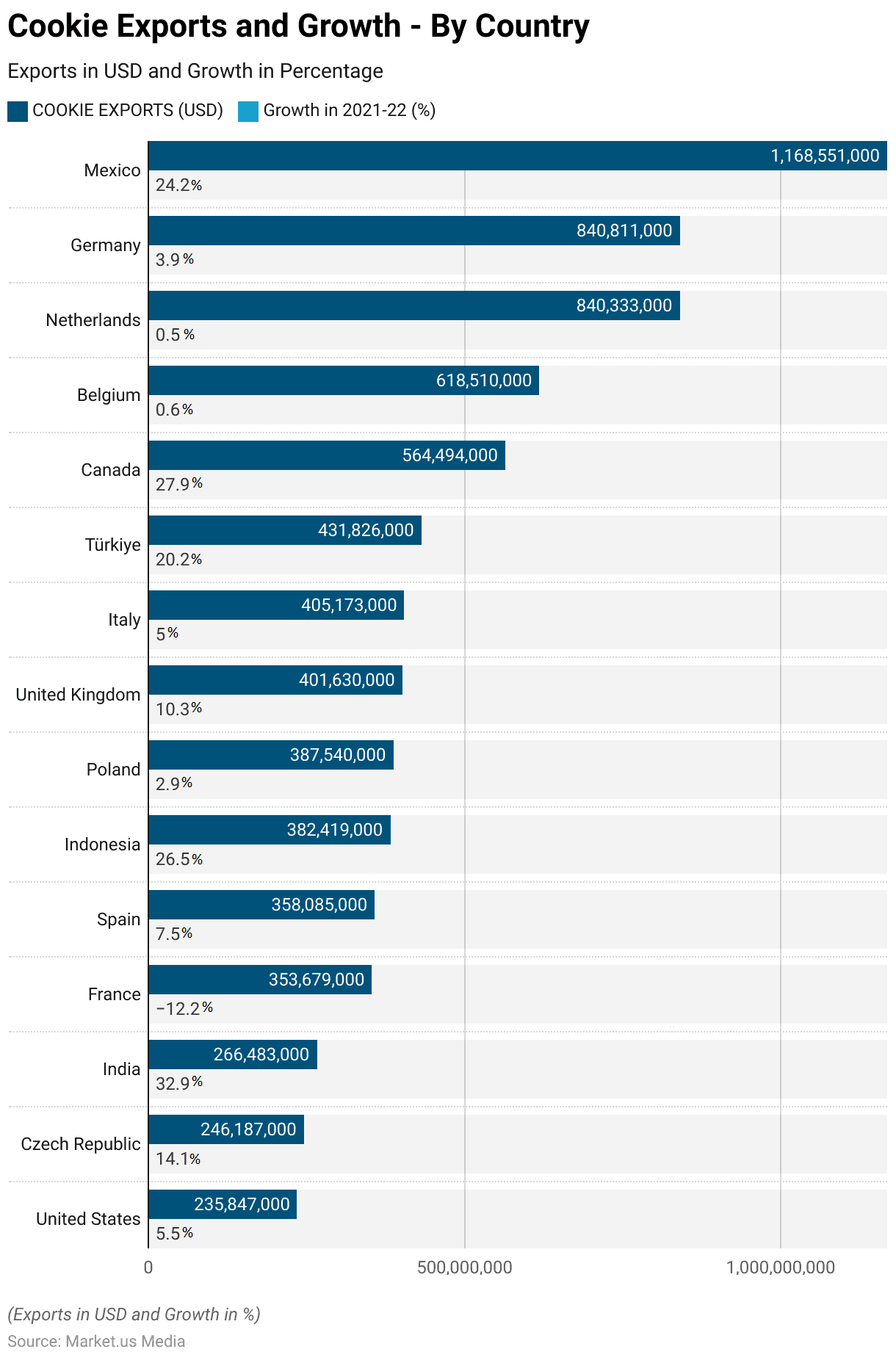
Latest Trends in Cookies & Snacking
- The practice of checking nutrition labels on snacks before purchase varies across different countries, as indicated by survey responses.
- In India, the majority of respondents, accounting for 86%, report regularly scrutinizing nutrition labels before buying snacks, reflecting a strong awareness of dietary choices.
- Similarly, in Indonesia and China, significant proportions of respondents, at 83% and 80% respectively, exhibit a proactive approach to assessing snack nutrition information.
- In contrast, the practice is less prevalent in countries like Mexico, Canada, and Brazil, with 75%, 70%, and 69% of respondents respectively indicating they check nutrition labels before snack purchases.
- In the United States, Australia, South Africa, France, and the UK, around half to slightly over half of respondents engage in this practice, while in Germany, the percentage is lower at 49%.
- These findings highlight varying levels of consumer consciousness regarding snack nutrition across different regions globally.
(Source: Mondelēz International State of Snacking 2022 Global Consumer Snacking Trends Study)
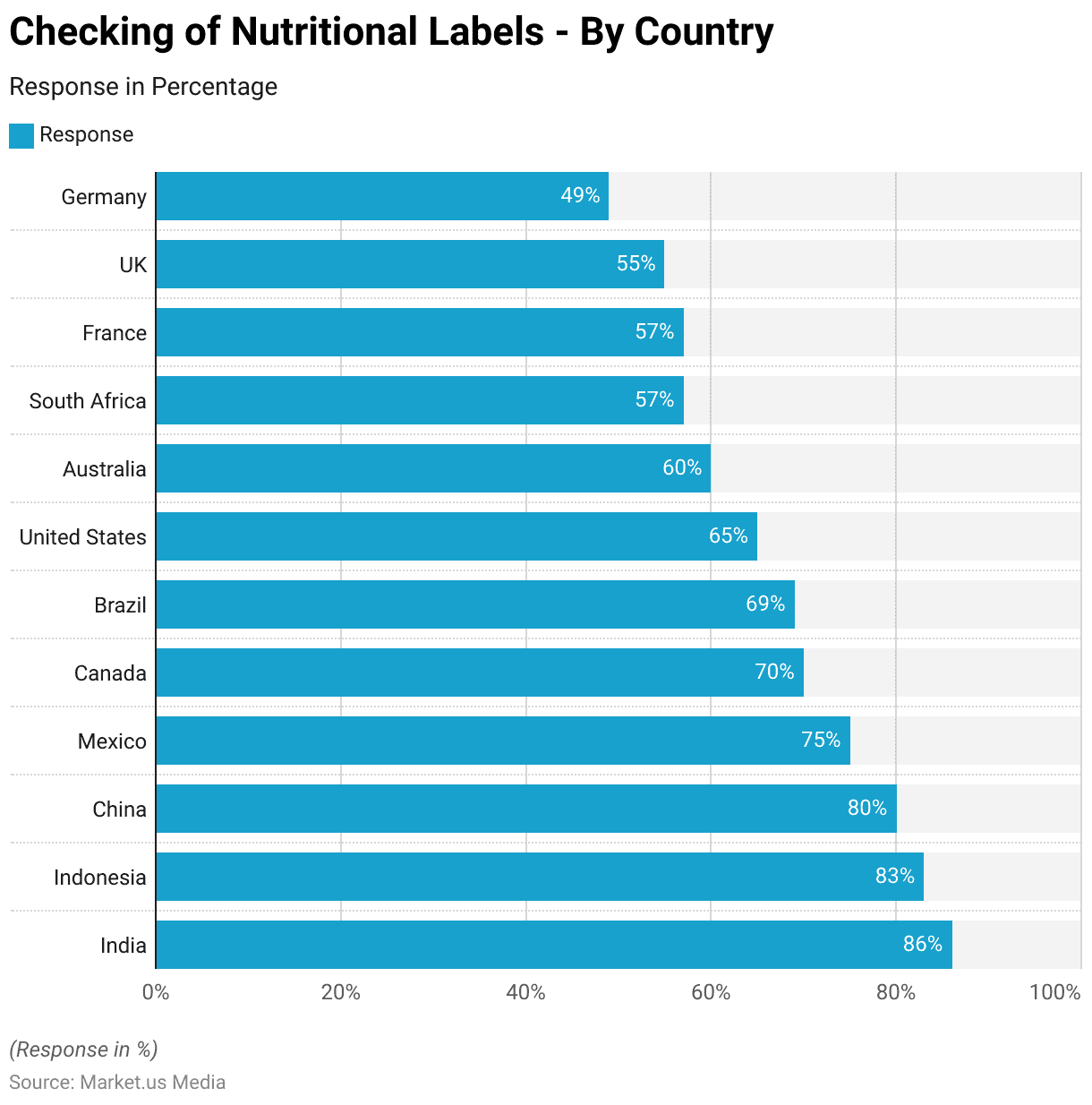
Regulatory Requirements for Cookies Statistics
- Regulatory requirements for cookies encompass various specifications regarding their composition and characteristics.
- These standards typically mandate minimum levels of certain components to ensure quality and consistency across products.
- For total solids, cookies must contain not less than 36.0 percent, ensuring a sufficient density and texture.
- Similarly, the weight/volume ratio (wt./vol) should not fall below 525 grams per liter to maintain adequate mass and volume.
- Regarding milk fat content, cookies must contain not less than 10.0 percent milk fat, ensuring a rich and creamy texture. However, the milk fat content should not exceed 2.5 percent to prevent an excessive greasy or oily consistency.
- Additionally, milk protein content (Nx6.38) must meet a minimum threshold, ranging from 3.0 to 3.5 percent, depending on regulatory requirements, to provide essential nutrients and contribute to the cookie’s structural integrity.
- These regulatory standards help ensure the quality and nutritional value of cookies available in the market, promoting consumer confidence and safety.
(Source: FSSAI)
Recent Developments
New Product Launches:
- Mondelez International launched eight HFSS-free products in August 2022, across various categories including biscuits and chocolate drinks.
- General Mills introduced a new flavor of Pillsbury mini soft-baked cookies in August 2022, targeted at convenience stores and featuring varieties like chocolate chip and peanut butter with chocolatey drizzle.
- Britannia Good Day in India launched the Good Day Harmony biscuit in July 2022, available in variants such as Hazelnut, Cashew, Pista, and Almond.
Strategic Partnerships:
- Girl Scouts and DoorDash Collaboration: In a strategic partnership aimed at modernizing cookie sales, the Girl Scouts of the USA teamed up with DoorDash, a leading food delivery platform.
- Through this collaboration, consumers can conveniently order their favorite Girl Scout cookies for delivery straight to their doorstep, enhancing accessibility and driving sales volume.
- Within the first month of the partnership, Girl Scout cookie sales through DoorDash surged by 30%, highlighting the success of the initiative.
Acquisition:
- Keebler Brand Acquisition by Ferrero: Ferrero, the Italian confectionery giant, acquired the Keebler brand and its associated cookie and cracker business from Kellogg Company.
- The acquisition, valued at $1.3 billion, expands Ferrero’s presence in the cookie market and aligns with its strategic objective of diversifying its product portfolio.
- With iconic brands like Keebler joining its lineup, Ferrero aims to strengthen its position in the competitive snack industry.
Investment in Sustainability:
- Sustainable Sourcing Initiatives by Cookie Manufacturers: Major cookie manufacturers are investing in sustainability initiatives to address environmental concerns and meet consumer demand for ethically sourced ingredients.
- Companies like Pepperidge Farm and Chips Ahoy! have pledged to source sustainable cocoa and palm oil, reducing their environmental footprint and promoting responsible agricultural practices.
- These brands aim to enhance their corporate reputation and appeal to environmentally conscious consumers by aligning with sustainability goals.
Digital Innovation:
- Cookie Brands Embrace E-commerce and Social Media Marketing: In response to shifting consumer shopping habits, cookie brands leverage e-commerce platforms and social media marketing to engage with their target audience and drive online sales.
- Brands like Famous Amos and Tate’s Bake Shop actively promote their products through targeted digital advertising campaigns and influencer partnerships, capitalizing on the widespread use of social media platforms among younger demographics.
Conclusion
Cookies Statistics – In summary, cookies retain their status as a beloved and adaptable snack worldwide. With classic favorites like chocolate chip and innovative options like tea-infused or gingerbread varieties, there’s a cookie to satisfy every palate.
The global cookies market enjoys consistent growth driven by convenience, taste, and evolving consumer preferences for healthier and gourmet options.
Whether packaged or freshly baked, cookies offer a convenient and delightful snack for various occasions, from quick treats to social gatherings.
Regulatory standards ensure the quality and nutrition of cookies, instilling consumer confidence. As dietary awareness evolves, the market responds with diverse options to meet changing preferences. Overall, cookies remain a timeless indulgence, bringing comfort and joy to consumers of all ages.
FAQs
Cookies, also known as biscuits in some regions, are small, sweet, baked treats typically made from a mixture of flour, sugar, fat, and flavorings like chocolate chips or nuts. They come in various shapes, sizes, and flavors and are often enjoyed as snacks or desserts.
Some of the most common types of cookies include chocolate chip cookies, oatmeal cookies, sugar cookies, peanut butter cookies, and shortbread cookies. These varieties differ in ingredients, texture, and flavor profiles.
Cookies are made by mixing ingredients such as flour, sugar, butter or oil, eggs, and flavorings to form a dough. The dough is then shaped into small portions, placed on a baking sheet, and baked in an oven until golden brown.
Yes, there are healthier options for cookies available, including gluten-free, sugar-free, and vegan varieties. These cookies often use alternative ingredients like almond flour, coconut sugar, and plant-based fats to reduce calories and increase nutritional value.
Cookies should be stored in an airtight container at room temperature to maintain freshness and prevent them from becoming stale. Some cookies may also be refrigerated or frozen for longer-term storage, depending on the recipe.
Discuss your needs with our analyst
Please share your requirements with more details so our analyst can check if they can solve your problem(s)



